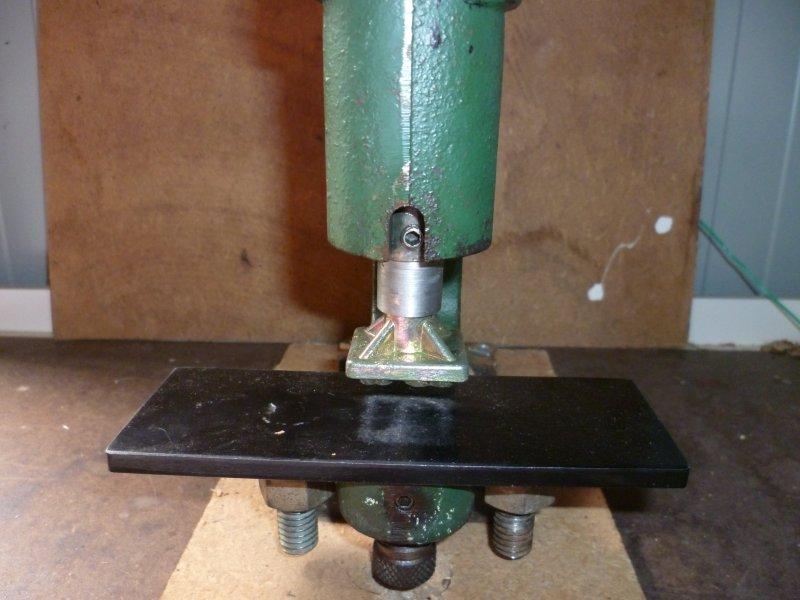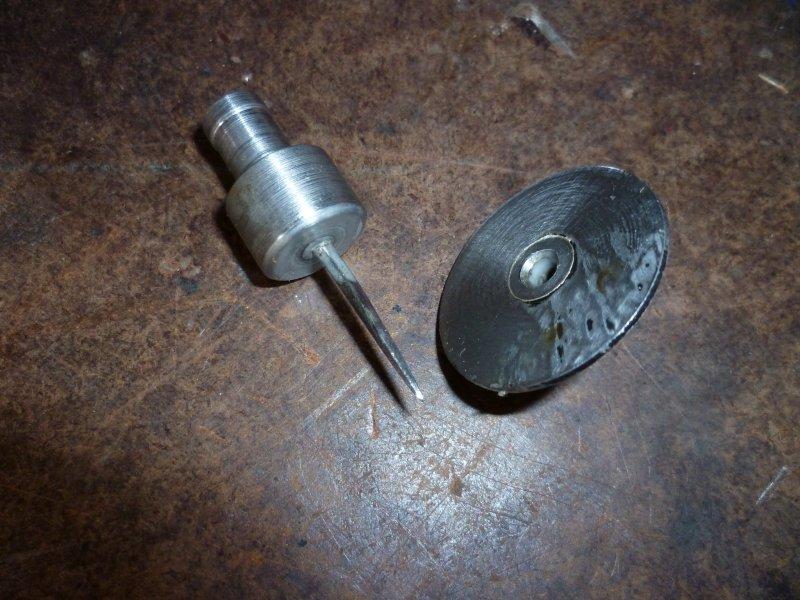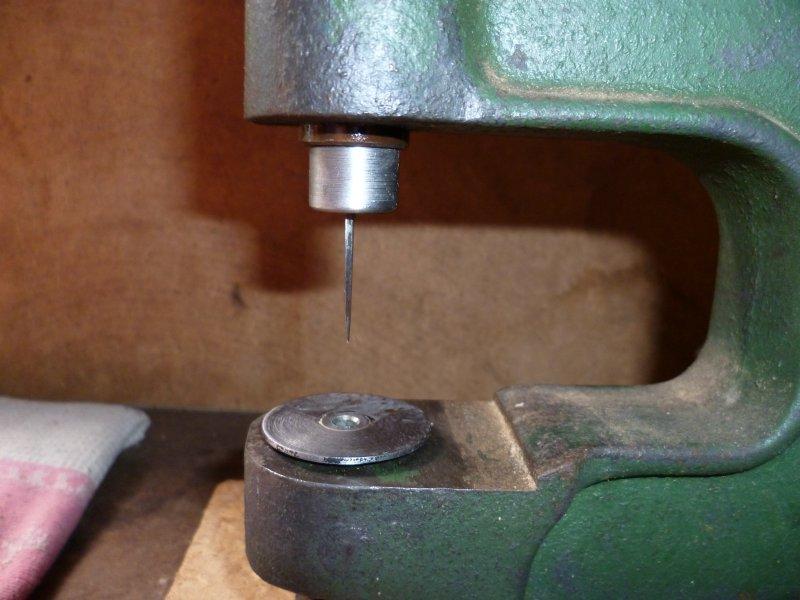-
Posts
4,793 -
Joined
-
Last visited
Content Type
Profiles
Forums
Events
Blogs
Gallery
Everything posted by dikman
-
Thanks folks. The chrome-tanned that I referred to was a very small piece and I just wanted to see what the engraving looked like on something black. The process was carried out right next to an open door, and I've already made a separate fan to blow towards the door. I'll be mostly working with veg-tan anyway (and definitely no more engraving of chrome-tanned). Grant, thank you for the concise explanation of what is released from those products, that sort of info is usually buried away under too much writing! I'm sure there are others here who will appreciate it too. Besides, I can't afford to lose any more brain cells as I think I lost too many during my younger drinking days!!
-
The limiting factor is the travel of the piston. It's going to require a re-design to get more travel. I'm working on it.
-
The 51W55 is not a walking foot. Not much good for holsters (unless they're very thin holsters!).
-
Already thought of that but there's no such thing as a "cheap arbor press" here in Oz!
-
Having recently acquired 3 Carr presses (for snaps, rivets etc) I thought they must be useful for something else. I made an adapter for alphabet stamps. The shaft that fits into the socket on the stamps has a supermagnet glued to the end and a small washer was glued into the bottom of the shaft on each stamp (because they're non-magnet). The magnet is just strong enough to stop the stamp from falling off. A short piece of bar fits over the base to press against. My sewing machines are limited to 3/8" thick leather (although one can just get through 1/2") and the last time I tried sewing a welt on a holster I had all sorts of trouble getting an awl through. In amongst all the gear I recently got was an awl needle, obviously meant to be pushed into a handle. I made an adapter to hold the needle and glued it in with JBWeld, then made an adapter plate for the bottom of the press. I had to modify the cam action of the handle a little to get the maximum travel I could, which is 3/4". It goes through that thickness with no effort at all. If I can figure out how to make a new handle with a better designed camming action, I will then be able to get 1".
-

Just pulled the trigger on a Cowboy CB4500!!!
dikman replied to fallequinox's topic in Leather Sewing Machines
Lucky you. I can understand why you want to shout it from the rooftops! -
Don't forget that hand stitching thinner materials with relatively large thread is easy but machine stitching such items is not!
-
I've been trying to convince myself to learn 3D modelling so I could make a maker's mark stamp, but without success (every time I try it all gets too hard!). So, having recently bought one of those dinky little laser engravers I thought "I wonder....". A bit of doodling later with photoshop and I got something that sort of works. Not sure how practical it is yet. The round one gives better detail on the cactus but smaller printing, the oval one is probably a better design, with larger lettering, but then I loose detail on the cactus. A work-in-progress, as they say. Oh, and burning into garment leather (chrome tan, I guess) stinks!!!!!!!
-

Please help, thread is too tight when pass bobbin
dikman replied to Orrrmygod's topic in Leather Sewing Machines
Probably a smart move, I think. Stitching looks good on the wallet. -

Please help, thread is too tight when pass bobbin
dikman replied to Orrrmygod's topic in Leather Sewing Machines
The motor/speed reducer shouldn't have anything to do with your problem. From the look of your video the gears are out-of-mesh underneath the shuttle. You have two choices - as has been mentioned find a sewing machine mechanic who can fix it or, if you insist on doing it yourself, spend a LOT of time reading posts and studying various manuals of similar type machines because you need to be sure you understand what you're doing. There is a limit to the advice people can give via a forum and mostly it assumes a reasonable mechanical knowledge on the part of the person with the problem for anything other than simple issues - and this is not a simple issue. -

Pfaff 335, Adler 69 type Cylinder arm caps.
dikman replied to RockyAussie's topic in 3D Printers and Lasers
I haven't actually tried it working so I'll have a look tomorrow. -

Please help, thread is too tight when pass bobbin
dikman replied to Orrrmygod's topic in Leather Sewing Machines
I'm not familiar with your machine but it is extremely unlikely that there is a clutch underneath the bobbin case. The clutch that Wiz is referring to is quite large and is located in a completely different place on machines that have one. Unless you have some idea about adjusting and timing machines, and have a suitable manual, I would not advise removing that bobbin case assembly. -

Pfaff 335, Adler 69 type Cylinder arm caps.
dikman replied to RockyAussie's topic in 3D Printers and Lasers
I'm trying hard not to feel insulted...... I might not have mastered creating 3D objects but the slicer programme is fine (I've made enough mistakes to suss it out!). Over the years I've realised that the initial design of something is not my strongpoint, but I'm very good at modifying/changing/adapting things once the hard work has been done (by someone else ). That's why I'm in awe at the relative ease with which you churn out these things!!! (And it's why I like thingiverse). -

Pfaff 335, Adler 69 type Cylinder arm caps.
dikman replied to RockyAussie's topic in 3D Printers and Lasers
You could check 3D printer forums too? Might find someone in your area that could do it and probably be cheaper than shipping from here to Canada (shipping costs from Australia to anywhere are notoriously high!). -

Pfaff 335, Adler 69 type Cylinder arm caps.
dikman replied to RockyAussie's topic in 3D Printers and Lasers
Do you know anyone with a 3D printer? It's not a very big print job for someone to do. Even my local library has one. -
You could only get it to stay up while the knee lift is operated, once you let go of the lift it would drop. Same as using a "normal" manual knee lift except you're using electrics/pneumatics to operate it instead of brute force! Anything else is going to be awfully complicated (assuming you could actually do it!).
-
John, I reckon you'll have fit a separate external power supply to operate the knee lifter. You'll have to work out the connections on the 4-pin from the knee lifter and find out what the operating voltage is, plus how you can bypass the old control box because you obviously want to remove that completely. Just a thought, where does the air supply come from?
-
I suppose you could glue it to a backing board for greater rigidity when tapping it?
-

Pfaff 335, Adler 69 type Cylinder arm caps.
dikman replied to RockyAussie's topic in 3D Printers and Lasers
Ah, so it's not just me...... Brian, you may notice that my cap seems to have pushed in a bit further than yours (not that it makes any difference) so you could probably make it about 3mm longer, I guess? -
No argument from me re-PayPal, but I do find it very useful with ebay purchases. My mistake (because I didn't know any better) was that I lodged a claim with ebay and they suggested I claim through PayPal. Once I initiated that claim ebay said they couldn't help because it was now with PayPal, although one of their supervisors said that in good faith they would refund my shipping costs once I sent them the receipt (would have been about $200). I refused to "return" it to the UK because Australian Consumer Law said it was the seller's responsibility to recover the goods. Anyhow, if you ever have problems try and stick with ebay's resolution process.
-

tooled black powder rig . . .
dikman replied to Chakotay's topic in Gun Holsters, Rifle Slings and Knife Sheathes
Care to give a bit of info on your leather ageing process? Looks good. -
Very clever, Chakotay.
-
Be careful with ebay's return policy, it is 30 days. PayPal is 180 days BUT to claim a refund they require you to return the goods first, at your expense. I recently bought a mini metal lathe off ebay, sold and shipped from within Australia. It was not what was advertised but even though it shipped from here the return address given by PayPal was the UK!!!! It took me three months of fighting and it wasn't until I involved the Financial Services Ombudsman that they grudgingly gave me a refund. The Juki sounds like the better machine, plus you're dealing directly with the seller. Me, I'd be very wary spending that sort of money on ebay.
-
I decided to have a closer look at the stamps. The geometric ones are all Porter and Co. stamps, a couple are Leathercraft NZ and the rest Craftool. I have a few Craftool that I bought recently and compared them to the old ones - there's a world of difference! The old ones have better definition and just look better. I also found a .pdf chart from Tandy that lists the old and the new stamps and it's obvious that Craftool have severely reduced the number of stamps that they make. Many of mine are no longer made.
-

Pfaff 335, Adler 69 type Cylinder arm caps.
dikman replied to RockyAussie's topic in 3D Printers and Lasers
They look nicer than mine - but the plastic one will be fine, it cost me almost nothing to make and I can easily make another if I need to.







